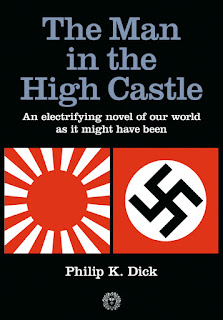Well I'm back with another flag haul. This is another project I did in collaboration with Lynn Davis. You may have heard that Lynn and I have had a bit of a falling out and...well, it's true. To be perfectly honest it was only a matter of time before this happened. Lynn has some strong opinions, and she doesn't take kindly to those who disagree with her. Well, that's the Tumbler set for ya. I could have kept quiet, but I figured if Lynn was really my friend she wouldn't break off out friendship over a disagreement of opinion...apparently not.
But you didn't come here to talk about my personal life, you came for the flags. These flags come from a world where the American Revolution was peacefully avoided, and Britain's former American colonies were organized into a European Union-esque organization. These flags were a spin-off from Lynn's previous map Excelsior. Let's meet them, shall we?
Here we have the flag of New York. It's orange, white and blue to reflect New York's Dutch heritage and the design reference's New York's Iroquois heritage. It comprises New York and the Ontario Peninsula. Like most entire's on this list it's
a European style liberal democracy with separation of church and state and a
healthy advocacy of democracy without being too OTL French style.
Here we have the Confederated State of America, or CSA for short. It comprises Pennsylvania, New Jersey, Wisconsin,
Michigan, Delaware, northern Ohio, Indiana, Illinois, and some of Minnesota. I made it look kind of like the Freedom Party flag from Timeline-191 for purposes of allohistorical irony.
Here we've got the flag of Vermont. It's basically the same as the northern states, but
with more of a libertarian bent to its politics. It's design is based on the historical flag of Vermont.
Next up is the flag of Manitoba. Comprising OTL Manitoba, Saskatchewan, Alberta, Yukon,
Northern Territories and Nunavut. It is a very liberal and progressive
democracy based on the radical democratic ideals of Thomas Spence, who founded
the state. It's not very religious and believes absolutely in the ideals of
democracy and the people. It features Liberty leading the people with a sword at the ready to strike down tyrants, and the motto is emblazoned above her.
Now on deck we have Louisiana. It comprises the southern half
of the Louisiana Purchase. It's a French Revolution style democracy due to the
failure of the French Revolution leading many refugees to flee to Louisiana,
which later joined the United States. It's Catholic, French speaking and kind
of does its own thing compared to the other states. Based on the historical flag of Louisiana.
Here we've got New England. OTL New England minus Vermont. You might be wondering
why New England has six stars, well it's beacuse each subdivision gets a star
and there's also a star for New England as a whole. Alternatively, the stars
are purely decorative (that's my story and I'm sticking to it). Anyway, New
England is a social democracy in the style of Europe, but without being too
French. It has separation of church and state. It is very religious without
being very conservative, and religion rarely factors into its politics.
Next up is Florida. OTL Florida plus the coastal regions of Mississippi
and Alabama. Like most of the southern nations it's a conservative democracy like Poland or Italy, and usually
has a lot of crazy politics and backwater bumpkins running things. Not as
progressive as the other states and religion factors a lot into day-to-day
operations.
Up next is Georgia. The Xs can be interpreted as Saint Andrew's crosses, but I thought it would be funny if such a conservative nation inadvertently had a reference to hard core porn on it's flag.
Here we have Carolina. Comprising Tennessee and the Carolinas. The cotton bush is a reference to the state's primary economic engine.
Next up is Canada. Comprising OTL Quebec, Ontario minus the peninsula,
Prince Edward Island and Larbador.
And here's the flag of Maryland. I thought he knight was a night touch.
Say hello to Oregon. Comprising OTL Oregon, Washington State, British
Columbia and Idaho. The killer whales reflect the region's native heritage and the wave symbolize the importance of the sea to the people of Oregon.
Here we have the flag of Alabama (Alabama and Mississippi minus their coastal regions). It's the only majority black state of
the United States and as such is a Switzerland style direct democracy with
emphasis on everyone being represented. It's very religious, but religion
doesn't really factor into politics. There's also strong feelings of
Pan-Africanism throughout the state, and that's reflected in the flag.
This is the flag of Acadia, comprising OTL Nova
Scotia and New Brunswick. Yeah, it's basically the flag of Acadia Parish, this one beat me up.
This is the flag of Lakota. Comprises the northern half of the Louisiana
Purchase. It’s red and has tepees to reflect the high native population. It’s
a pennant flag to mix things up.
This one's the flag of Virginia. Comprising Virginia, West Virginia,
Kentucky, southern Ohio, Indiana and Illinois.
Finally, we have the flag of the United States as a whole. I used purple because it's such an under-utilized color. I went with a Romanesque/Futuristic design because it pleased me and I liked that it seemed slightly sinister, even though this isn't a dystopia. Well, that and I'd been watching The Hunger Games movie.
Well we've reached the end of our list. my teamwork with Lynn is over, but at least I got some good flags to show off. Also, if you'd like me to make some flags for you let me know and I'll see what I can do. I can't guarantee it'll be a showstopper, but I'll certainly try my best. No charge of course.
Well that about does this for this flag haul. I'll see you guys next time

























